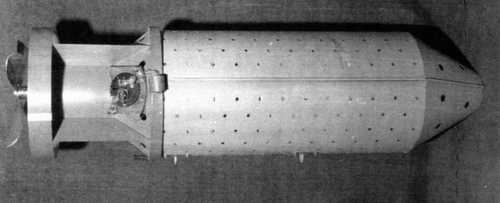
US Army Air Force
WW2's wackiest weapon ?
US Government.
This is the bat bomb. It is actually a cardboard cage (or cage container), designed to be dropped over the target where, having reached low altitude, it would open and release a large number of Mexican free-tailed bats, each carrying a small incendiary charge. The bats would then roost under the eaves of buildings and, in due course, ignite, spreading fire and destruction far and wide. I kid you not. Even I could not make this up. The idea resulted from the observation that Japanese cities in the 1940s were largely composed of wooden buildings. However, in the early part of the war, it was not possible for US aircraft to make effective airstrikes to set them on fire. Dr Lytle S. Adams conceived the idea that effective bat bombs - much lighter than conventional blast bombs and incendiaries - could be delivered over Japanese industrial cities from long range by the bombers then available. Thus, large parts of Japan's industrial capacity could be destroyed or crippled. Dr Adams was not a defence scientist or an engineer; he was a dentist. Figures. I am indebted to some bat-fixated geographers from the University of Santa Barbara (I almost went to do research there, a long time ago) for the following "pitch" for the bat bomb programme which was, incredibly, approved by President Roosvelt - "Bat Bomb Ingredients: - 180 Mexican free-tailed bats - 180 miniature incendiary bombs (oblong nitrocellulose cases filled with thickened kerosine) weighing 17 grams each which will burn for 4 minutes with a 10 inch flame or 180 of them weighing 28 grams each which will burn for 6 minutes with a 10 inch flame) - 180 small time-delay igniters, cemented to each bomb case along one side - 1 cardboard conainer with a parachute that will open automatically in mid-air at about 1,000 feet when dropped from a B-25 flying at 5,000 feet Bat Bomb Instructions - Place bats in refrigerators to induce temporary hibernation - Attach bomb cases and igniters, to the loose skin on each bat's chest with a surgical clip and a piece of string - Pack bats into the cardboard container - Repeat the above until you have about 3,500 bat bombs - Using a b-25 flying at 5,000 feet, drop the bat bombs over a city at night - When the parachutes deploy at 1,000 feet, the bats will awaken in the warmer air, fly out of the cardboard boxes, spread out from the point of release, and, at dawn, will hide in buildings across the target city. Shortly thereafter, the time-delay ingiters will set off the incendiary bombs, causing widespread fires and chaos (and, sad to say, killing the bats)." Initial tests, conducted by the US Army Air Force, did not exactly go well. Many bats dropped in the prescribed manner did not wake up from their temporary hibernation. The dropping and distributing method was unreliable - many bats were killed on impact with the ground. The destructive highlight of the programme occurred, not in Osaka, but in the Auxiliary Army Air Base at Carlsbad, New Mexico. A large force of bats, armed, primed and readied to take part in a test, escaped, and hid out, not only in the base's buildings, but also in the comfy hidey-holes supplied by heaps of tyres, ammunition stores, fuel tanks ... the resulting conflagration certainly caused "chaos"; in fact, it pretty well destroyed the Carlsbad base. This sort of thing seems to have dampened the Army's enthusiasm for the proposed weapon. The project was passed to the Marines, who named it "Operation X-Ray". Tests conducted by the Marines in 1944 in simulated operational conditions persuaded them (somehow) that the Bat Bomb was an effective weapon. One suspects that this estimation was somewhat optimistic. By this stage, however, the US pincer movement across the Pacific was bringing American bombers close to practical bombing range of Japanese cities, which were, indeed, destroyed by US bombers by fire - but using conventional incendiary bombs. Dr Adams maintained his faith in the concept but, in the end, the Bat Bomb was never deployed. Dr Stanley Lovell, Director of the US Office of Strategic Services, OSS, subsequenly described the Bat Bomb project as "Die Fledermaus Farce". My own conclusion ? Ingenious idea but, in the end of the day, pretty batty .... Yours from the Batcave, JR.
3081 Views
2/8/2012
